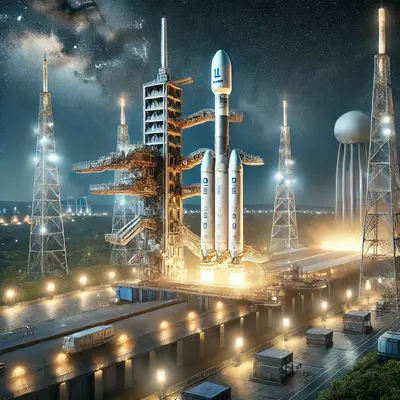In the world of space exploration and satellite communication, India is making significant strides. The recent launch of LVM3 M2/OneWeb India-1 is a monumental achievement, and it’s catching global attention. If you’ve come across the keyword “rajkotupdates.news:lvm3 m2/oneweb india-1”, you’re probably curious about what makes this event so special. Let’s break it down for you in simple terms.
What is LVM3 M2/OneWeb India-1?
The LVM3 M2 rocket, formerly known as GSLV Mk III, is India’s heavy-lift rocket developed by ISRO (Indian Space Research Organisation). The OneWeb India-1 mission is a collaborative project between ISRO and OneWeb, a UK-based company aiming to build a global satellite network for broadband services. This mission successfully placed 36 satellites into low-Earth orbit, marking a big win for both India and global connectivity.
Why Does This Launch Matter?
This launch isn’t just another notch in India’s space journey—it’s a game-changer. Here’s why:
Global Connectivity: OneWeb’s satellites are part of a larger plan to provide high-speed internet across the globe, even in remote areas.
India’s Rising Space Power: With this launch, India has proven its capability to handle high-profile international missions.
Cost Efficiency: ISRO’s expertise in low-cost yet highly reliable launches makes India a preferred partner for global companies.
A Quick Look at LVM3 M2
Before diving deeper, let’s understand what makes the LVM3 M2 so special:
Heavy-Lift Rocket: It can carry heavier payloads, making it ideal for missions like OneWeb that involve multiple satellites.
Reliable Design: This rocket has been tested and proven in various missions, including the Chandrayaan-2 lunar mission.
Dual Role: It supports both commercial and strategic missions, showcasing its versatversatile
The Partnership: ISRO and OneWeb
The collaboration between ISRO and OneWeb is a classic example of how partnerships can accelerate progress. While ISRO provided the launch expertise, OneWeb contributed its cutting-edge satellite technology. This mission is part of a larger agreement where ISRO will help launch a series of OneWeb satellites in the coming months.
How Does OneWeb Work?
OneWeb is building a constellation of satellites in low-Earth orbit (LEO) to provide fast and reliable internet services. Here’s a simplified explanation:
Satellites in LEO: These satellites are placed closer to Earth than traditional satellites, reducing latency (lag).
Global Coverage: Once complete, the constellation will cover every corner of the globe, even places where traditional broadband can’t reach.
Affordable Internet: The aim is to make high-speed internet accessible to people in rural and underserved areas.
Key Milestones of the Launch
Let’s break down the event for clarity:
1. Launch Date: The mission took off on October 22, 2024.
2. Location: The launch happened at Satish Dhawan Space Centre, Sriharikota, India.
3. Payload: A total of 36 OneWeb satellites were deployed into orbit.
4. Success Rate: The mission was flawlessly executed, cementing India’s position as a reliable space partner.
Impact of This Launch
The success of LVM3 M2/OneWeb India-1 has several implications:
1. Revolutionizing Internet Access
This mission is a step toward bridging the digital divide. Once operational, OneWeb’s satellite network will bring internet connectivity to millions who currently have limited or no access.
2. Boosting India’s Space Economy
By handling high-profile missions like this, India is attracting more international clients. This not only boosts revenue for ISRO but also strengthens India’s reputation in the global space market.
3. Technological Advancements
Each mission pushes the boundaries of what’s possible, encouraging further innovation in satellite and rocket technology.
Challenges Overcome
No great achievement comes without its hurdles. Here’s what made this mission stand out:
Precision Deployment: Placing 36 satellites in the correct orbits is no easy feat, but ISRO made it look seamless.
International Collaboration: Working with global partners like OneWeb required exceptional coordination and communication.
Tight Deadlines: The mission was completed within the stipulated timeframe, showcasing ISRO’s efficiency.
Why You Should Care
You might wonder, “How does this affect me?” Here’s why this matters:
Faster Internet: Once the OneWeb network is live, even remote areas will enjoy high-speed internet.
Economic Growth: Projects like these create jobs and drive technological innovation.
National Pride: It’s a reminder of India’s growing influence in the space and tech industries.
Conclusion
The LVM3 M2/OneWeb India-1 mission is more than just a technical achievement; it’s a step toward a more connected and inclusive world. With ISRO’s expertise and OneWeb’s vision, the future of global connectivity looks bright.
India’s role in space exploration is growing, and missions like these prove that the sky is not the limit—it’s just the beginning
FAQs
1. What is LVM3 M2?
LVM3 M2, formerly GSLV Mk III, is India’s heavy-lift rocket capable of carrying large payloads into space.
2. What is OneWeb?
OneWeb is a UK-based company building a global satellite network to provide high-speed internet services.
3. How many satellites were launched in this mission?
A total of 36 OneWeb satellites were deployed into low-Earth orbit.
4. Why is this launch important?
It’s a major step in improving global internet access and highlights India’s capabilities in space exploration.
5. How does OneWeb’s network work?
OneWeb uses low-Earth orbit satellites to deliver fast, reliable internet with minimal lag.
6. What’s next for ISRO and OneWeb?
ISRO will continue launching more OneWeb satellites as part of their ongoing partnership.
This mission is not just about satellites; it’s about connecting people, fostering innovation, and showcasing what’s possible when nations and companies come together for a common goal. Keep an eye on India’s space program—there’s plenty more to come!





Leave a Reply